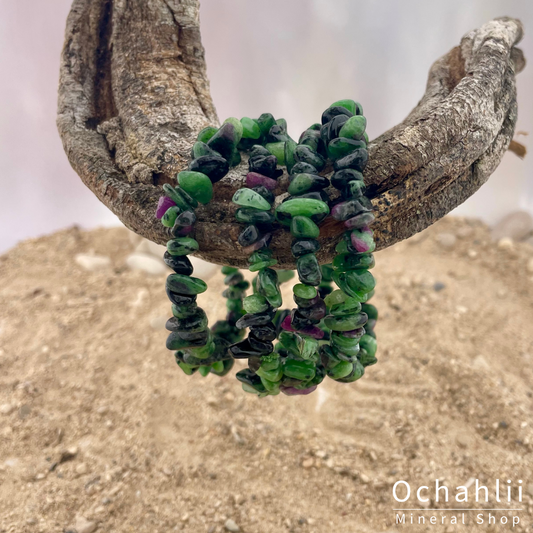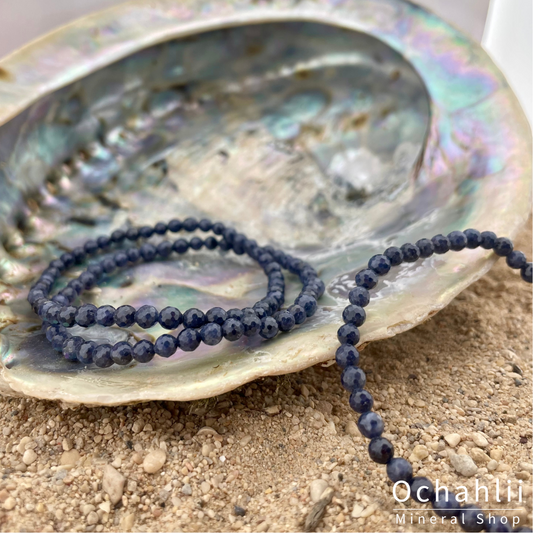
The Beautiful World of Corundum with Ruby and Sapphire as the protagonists.
Share
In the fascinating world of gemstones, the corundum family, with its illustrious members the ruby and sapphire, occupies a place of royal allure. These gemstones, both varieties of the mineral corundum (Al₂O₃), have enchanted humanity over the centuries not only with their breathtaking beauty, but also with their remarkable hardness and durability. Today we delve deeper into the fascinating journey of ruby and sapphire, from their geological birth to their legendary status in the annals of history.
Characteristics of Corundum
Corundum is a very hard mineral, with a hardness of 9 on the Mohs scale, making it the third hardest natural mineral, after diamond (with a hardness of 10) and moissanite. It occurs in a variety of colors depending on the trace elements present during formation. Iron, titanium, chromium, copper and magnesium can affect the color of corundum, resulting in a broad spectrum of shades.

Ruby and Sapphire
- Ruby is formed by the presence of chromium and exhibits shades ranging from light pink to a deep, dark red.
- Sapphire is colored by the presence of iron and titanium and is usually known for its blue hues, although it can come in almost any color except red (which are classified as rubies). Sapphires that are not blue are often referred to by their color preceding the word sapphire, such as "yellow sapphire" or "pink sapphire".

Other Varieties
In addition to rubies and sapphires, the corundum family includes some lesser-known varieties:
- Padparadscha : A rare and valuable pink-orange sapphire mainly found in Sri Lanka. These stones are highly sought after because of their unique color.
- Star ruby and star sapphire : These stones exhibit an asterism or the appearance of a star-like figure on the surface when viewed under a single light source. This effect is caused by the presence of needle-like inclusions of rutile.

DeLong Star Ruby, one of the most unique and beautiful rubies.
- Fancy sapphires : These are sapphires that appear in every color except blue and red. They range from yellow, green, orange to purple and offer a wide spectrum of aesthetic options.
Locations
- Rubies are mainly found in Myanmar (formerly Burma), Thailand, Sri Lanka, and Madagascar. The "Valley of the Rubies" in Myanmar is particularly famous for its high-quality rubies.
- Sapphires come from various locations including Kashmir (India), Myanmar, Sri Lanka, and Madagascar. The sapphires from Kashmir are known for their exceptional quality and deep blue color.
Historical Role
The names "ruby" and "sapphire" each have fascinating etymological origins dating back to ancient languages and cultures, reflecting how these gemstones have been prized and admired for centuries.
Ruby
The name "ruby" comes from the Latin word "ruber", which means "red". This name is a direct reference to the striking red color of the gemstone. The term passed through several languages before taking its current form, including the Old French "rubi", which eventually formed the basis for the modern name in many languages. The deep red color of the ruby has always had a strong association with passion, love, and vitality, contributing to the enduring allure and appreciation of this gemstone throughout history.

The Sunrise Ruby is the most expensive ruby in the world and has a value of almost 30 million Euro.
Sapphire
The name "sapphire" is derived from the Greek word "sappheiros", which may have originally denoted another blue gemstone, such as lapis lazuli. There is also a connection with the Hebrew "sappir", which is strongly associated with the color blue. The term "sappheiros" was later adopted into Latin as "sapphirus", eventually evolving into the modern name "sapphire" in several languages. This etymological journey reflects the appreciation and mystical importance that ancient cultures placed on the beautiful blue color of sapphires, which was often seen as symbolic of heaven and divine favor.
Rubies and sapphires have played an important role throughout history, both in royal regalia and in mythologies and religious traditions.
- Rubies were considered the king of gemstones, symbols of passion, power and high social prestige. In ancient times, it was believed that rubies offered protection against evil and misfortune. They were often worn by royalty and nobility as a sign of wealth and prosperity.
- Sapphires are equally significant, associated with wisdom, purity and divine favor. In the Middle Ages, they were worn by clerics as a sign of heaven, while kings and warriors wore sapphires for protection and fortune in battle.
Industrial Use
Due to its hardness, corundum is also widely used in industrial applications, including as an abrasive in grinding and polishing processes and in certain types of watch crystals and electronic substrates.
Transparent or opaque?
The quality of rubies is influenced by factors such as color, clarity, cut shape, and carat weight, with transparency being a crucial factor in their appreciation and use. Transparent rubies, especially those with a deep red color, are the most valuable because of their ability to transmit light, leading to better color saturation and brilliance. Semi-transparent rubies also have value due to their attractive color and minimal inclusions. Opaque rubies, which do not transmit light, are less desirable for high-end jewelry but can still be attractive for decorative or artistic jewelry, especially in unique designs that focus on the character of the stone.
Spiritual characteristics
Rubies , with their deep red color symbolizing the essence of fire and blood, have been revered for centuries as stones of life force, vitality and passion. They are known for their ability to strengthen the wearer's courage, optimism and the will to live. In spiritual traditions, rubies are considered powerful protectors against negative energies and evil, making them valuable amulets for both physical and psychological protection. These gemstones are also associated with love and passion, amplifying the deep, fiery emotions between people and promoting commitment within relationships. By stimulating the Heart Chakra, rubies help open the heart to unconditional love and compassion, not only enriching the wearer physically and emotionally, but also providing a path to spiritual awakening. Wearing a ruby is seen as a means to promote well-being and spiritual growth, creating a bridge between earthly desires and spiritual aspirations.
Sapphires , with their serene blue hues that evoke the heavens and infinity of the ocean, are considered symbols of wisdom, intellectual clarity and divine favor. These gemstones encourage the search for spiritual truth and support the development of self-discipline and inner peace. Traditionally, sapphires are believed to purify the mind, assist the wearer in overcoming obstacles on the path to spiritual enlightenment, and activate the Third Eye Chakra, leading to heightened awareness and a better understanding of the self and the universe. They are also known for their protective properties, which ward off negative energies and promote mental harmony. In relationships, sapphires symbolize loyalty, reliability and the sincerity of emotions, making them a popular choice for engagement rings and other commitment jewelry. Wearing a sapphire equates to embracing inner peace, pursuing spiritual growth and promoting a life of wisdom and integrity.
Conclusion
The corundum family offers a remarkable diversity of gemstones, ranging from the coveted ruby and sapphire to the lesser-known but equally fascinating varieties such as padparadscha and fancy sapphires. Their exceptional hardness and richness of color make them favorites in both jewelry design and industrial applications. Each member of the corundum family has its own unique beauty and character, giving them an enduring appeal through the ages.





